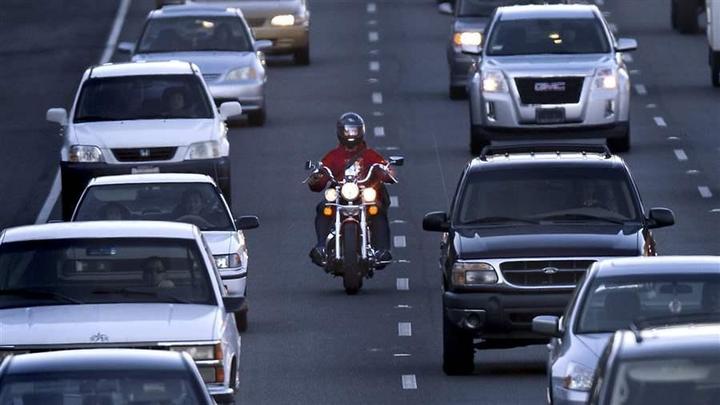If you ride a motorcycle in Texas, you may wonder whether you’re allowed to “lane-split” — that is, ride between lanes of traffic moving in the same direction or pass vehicles by riding between lanes. The clear answer is: no, lane-splitting is not legal in Texas. However, the legal landscape has changed in recent years, and motorcyclists should know the rules, risks and prospects for change.
What is lane-splitting (and how is it different from lane-sharing)?

Lane-splitting refers to a motorcyclist riding between lanes of slow-moving or stopped traffic (vehicles travelling in the same direction), or passing other vehicles by riding in the space between lanes. It is distinct from “lane-sharing” (two motorcycles ride side-by-side in the same lane) or “filtering” (riding between stopped vehicles, e.g., at an intersection). Many laws treat these separately.
In Texas, although lane-sharing is permitted under certain conditions, lane-splitting is explicitly prohibited.
What does Texas law say?
In Texas, the relevant law that settled the matter is House Bill 4122, passed during the 2023 legislative session and signed by the governor. According to published summaries, this law expressly prohibits a motorcyclist from:
- operating the motorcycle between lanes of traffic moving in the same direction; or
- passing a motor vehicle while in the same lane as the vehicle being passed.
- In effect, as of 2025, Texas Transportation Code (via this legislation) makes lane-splitting illegal.
Thus, the practice of riding a motorcycle between lanes of traffic (when cars are moving) is prohibited.
What are the consequences of lane-splitting in Texas?
If a motorcyclist engages in lane-splitting in Texas, several consequences may follow:
- A traffic citation/fine: some sources indicate drivers could be fined around US $175 or more for a violation.
- Increased risk in accident liability: if you are involved in a crash while lane-splitting (illegal), insurance companies or courts may assess greater fault against you.
- Potential for other charges: in certain circumstances, riding in a prohibited way could lead to reckless driving or other enhanced penalties.
It is important for riders to understand that even though the practice might have existed in a “grey area” in the past, this explicit prohibition means that relying on “no one told me it was illegal” is not a strong defence.
What is allowed instead?
While lane-splitting is illegal, Texas law does allow other related motorcycle practices:
- Lane sharing: Two motorcycles may ride side-by-side in the same lane, provided both riders agree and it does not impede the normal movement of traffic.
- Motorcyclists are entitled to the full use of a traffic lane (they have the same right to a lane as other vehicles). Other vehicles may not force them into sharing or unsafe positions.
These clarifications are vital because many riders confuse lane-splitting with lane-sharing or other manoeuvres.
Why did Texas ban lane-splitting?
According to legal commentary, the rationale for prohibition in Texas includes:
- Road width and design: Texas highways and urban roads often have heavy traffic, large-vehicle presence, and narrower margins between lanes, making lane-splitting more risky according to lawmakers.
- Driver expectations and safety: Other drivers may not anticipate a motorcycle passing between lanes, increasing collision risk.
- Legal clarity: Prior to HB 4122, the practice was in a grey zone — not clearly legal, but not strictly prohibited under a specific statute. The law ended that uncertainty.
Thus, Texas chose a conservative approach — prohibiting lane-splitting rather than integrating regulated allowances.
What should Texas motorcyclists do?
- Avoid lane-splitting altogether, as it is illegal and exposes you to fines or greater liability in a crash.
- Stay in your designated lane, maintain safe following distance, and use defensive riding techniques.
- Ensure you are visible to other drivers: use bright gear, keep your headlight on, anticipate vehicle lane changes or sudden stops.
- If you are in an accident, be aware that if you were lane-splitting, your conduct may be considered unlawful and may affect insurance coverage or liability.
- Keep up-to-date with Texas traffic law changes and consult a licensed Texas traffic or motorcycle-accident attorney if you are cited or involved in a crash.
Summary & Conclusion
In summary, lane-splitting in Texas is illegal. The 2023 law (HB 4122) removed ambiguity and codified the prohibition of riding a motorcycle between lanes of traffic moving in the same direction. Motorcyclists should treat lane-splitting as a traffic violation, with associated fines and liability risk. Although lane sharing and other safe riding practices remain legal, the practice of splitting lanes remains off-limits. Staying compliant means staying in your lane, riding defensively, and staying aware of any legislative shifts.

